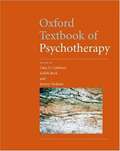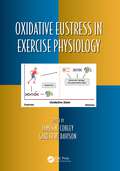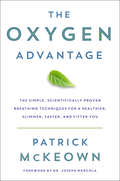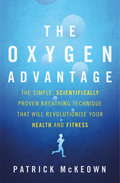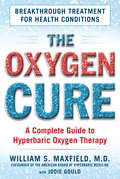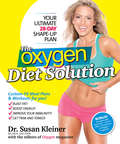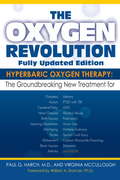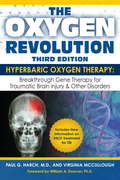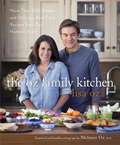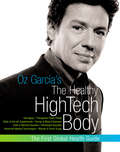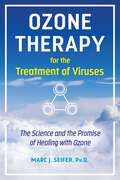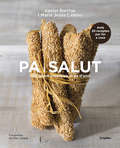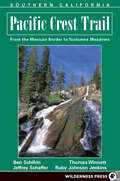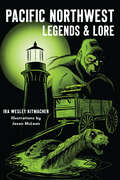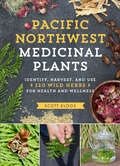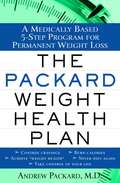- Table View
- List View
Oxford Textbook of Psychotherapy
by Glen O. Gabbard Judith Beck Jeremy HolmesThe first of its kind, this is a 'must have' volume for all trainee and practicing psychological therapists, whatever their background - psychiatry, psychology, social work, and nursing.
Oxidative Eustress in Exercise Physiology (Oxidative Stress and Disease #47)
by James N. CobleyOxidative Eustress in Exercise Physiology unravels key physiological responses and adaptations to different redox-regulated exercise paradigms at the cell, tissue, and whole-body level in model systems and humans in health and disease. While the mechanistic details are still unclear, key intracellular redox indices seem to be dysregulated with age. Consequently, beneficial molecular responses to acute endurance exercise decline in older individuals. Recent research suggests that manipulating mitochondrial redox homeostasis by supplementing with the mitochondria-targeted coenzyme Q10 for six weeks markedly improves physical function in older adults; i.e. it may be possible to maximise the benefits of exercise by manipulating the redox environment. The research described in this book suggests that significant translational potential exists with respect to cardiovascular disease, neurodegeneration and cancer. An international team of researchers documents the importance of redox biology in health and disease, especially when exercise is a clinically useful tool for the treatment of many diseases and conditions. Features Defines essential redox biology reactions and concepts in exercise physiology Assesses key redox parameters in an in vivo human exercise context Identifies the challenges, opportunities and boundaries of current knowledge Includes a critique of the underlying mechanisms Summarises examples of translationally important research relating to disease states Related Titles Draper, N. & H. Marshall. Exercise Physiology for Health and Sports Performance (ISBN 978-0-2737-7872-1) Wackerhage, H., ed. Molecular Exercise Physiology: An Introduction (ISBN 978-0-4156-0788-9)
Oxidative Stress and Toxicity in Reproductive Biology and Medicine: A Comprehensive Update on Male Infertility- Volume One (Advances in Experimental Medicine and Biology #1358)
by Kavindra Kumar Kesari Shubhadeep RoychoudhuryThis book discusses the role of oxidative stress in human reproduction with a focus on men’s health. The physiological roles of reactive oxygen species (ROS) in male fertility are the focus in this book. This topic is important because oxidative stress is a result of the imbalance between ROS and antioxidants in the body which may lead to sperm damage (DNA or count), deformity, and eventually, male infertility. Therefore, for a better understanding of the molecular mechanisms related to male genotoxicity and its regulation in infertility, this book provides an up-to-date view on the impact of oxidative stress factors in male reproduction . The main aim of this book is to collect a series of research articles and reviews from a diverse group of scientists to share their research work on the role of ROS or oxidative stress in physiological and pathological states in relation to (in)fertility in the male. This book presents various state-of-the-art chapters of the recent progress in the field of cellular toxicology and clinical manifestations of various issues related to men’s health and fertility. Topics include cell signaling, DNA damage and infertility, the pathophysiology of disease instigation and distribution, immune toxicity and prevention.
Oxidative Stress and Toxicity in Reproductive Biology and Medicine: A Comprehensive Update on Male Infertility Volume II (Advances in Experimental Medicine and Biology #1391)
by Shubhadeep Roychoudhury Kavindra Kumar KesariVolume Two advances the exploration of the fundamental principles of oxidative stress and toxicity on male (and female) reproduction. It includes the advances in research on male reproductive health, the impact of environmental factors, the protective measures using bioactive compounds and traditional medicines, and how to limit toxic exposure. It includes coverage of: Oxidative stress and male infertilityEnvironmental stressors and sexual healthHeavy metals, pesticides, fine particle toxicity and male reproductionProtective measures against oxidative stress in gametes/embryos by using bioactive compounds/phytomedicines in Assisted Reproductive Technology (ART)Role of reactive oxygen species on female reproductionRadiation and mutagenic factors affecting the male reproductive systemBoth volumes provide a comprehensive look at the most basic concepts and advanced research being conducted by world famous scientists and researchers in male infertility and reproduction.
The Oxygen Advantage: The Simple, Scientifically Proven Breathing Techniques for a Healthier, Slimmer, Faster, and Fitter You
by Patrick MckeownA simple yet revolutionary approach to improving your body's oxygen use, increasing your health, weight loss, and sports performance--whether you're a recovering couch potato or an Ironman triathlon champion. With a foreword by New York Times bestselling author Dr. Joseph Mercola.Achieve more with less effort: The secret to weight loss, fitness, and wellness lies in the most basic and most overlooked function of your body--how you breathe. One of the biggest obstacles to better health and fitness is a rarely identified problem: chronic over-breathing. We often take many more breaths than we need--without realizing it--contributing to poor health and fitness, including a host of disorders, from anxiety and asthma to insomnia and heart problems.In The Oxygen Advantage, the man who has trained over 5,000 people--including Olympic and professional athletes--in reduced breathing exercises now shares his scientifically validated techniques to help you breathe more efficiently. Patrick McKeown teaches you the fundamental relationship between oxygen and the body, then gets you started with a Body Oxygen Level Test (BOLT) to determine how efficiently your body uses oxygen. He then shows you how to increase your BOLT score by using light breathing exercises and learning how to simulate high altitude training, a technique used by Navy SEALs and professional athletes to help increase endurance, weight loss, and vital red blood cells to dramatically improve cardio-fitness.Following his program, even the most out-of-shape person (including those with chronic respiratory conditions such as asthma) can climb stairs, run for a bus, or play soccer without gasping for air, and everyone can achieve: Easy weight loss and weight maintenance Improved sleep and energy Increased concentration Reduced breathlessness during exercise Heightened athletic performance Improved cardiovascular health Elimination of asthmatic symptoms, and more.With The Oxygen Advantage, you can look better, feel better, and do more--it's as easy as breathing.
The Oxygen Advantage: The simple, scientifically proven breathing technique that will revolutionise your health and fitness
by Patrick McKeownThe secret to your health, fitness and overall wellbeing lies in the most basic and overlooked aspect of your workout: how you breathe. Developing body strength while ignoring breathing strength is counterproductive. In The Oxygen Advantage, Patrick McKeown combines his successful breathing exercises with techniques designed to simulate high-altitude training in a highly successful programme that will significantly improve anyone's health but will also empower athletes to improve their sports performance. These scientifically validated exercises have the potential to drastically improve your overall fitness, whether you are a habitual couch potato or an Ironman triathlon champion. These easy-to-use techniques can help to reduce your breathlessness, improve your sleep as well as reduce anxiety and stress. Drawing on his own experiences as an ex-asthmatic and the work he has done to help athletes and asthma sufferers alike to achieve greater fitness, Patrick shows you the key to a healthier, fitter you.
The Oxygen Cure: A Complete Guide to Hyperbaric Oxygen Therapy
by Jodie Gould William S. MaxfieldThe Best-Kept Secret in MedicineIn the United States, the FDA currently recognizes hyperbaric oxygen therapy (HBOT) for 14 conditions, including decompression sickness, embolism, crush injury, bone infection, burns, wound healing, severe anemia, and several others.Now, in The Oxygen Cure, hyperbaric expert William S. Max eld, M.D., will convince you that HBOT is a vastly underused modality that deserves to take its place among frontline medical treatments. As a holistic treatment, HBOT targets the underlying disease or condition, not just the symptoms.The Oxygen Cure reveals how hundreds of studies on HBOT conducted around the world prove it works at the cellular level to help or heal conditions such as: Stroke Chemo-Related Side Effects Epilepsy Fibromyalgia Emphysema & Asthma ADHD Rheumatoid Arthritis Cardiac Diseases Migraine & Vertigo Early Dementia Vision Loss Multiple Sclerosis & Parkinson's Disease Traumatic Brain Injury & PTSD And Dozens MoreFull of hope-inspiring case histories and expert findings, The Oxygen Cure shows how HBOT not only benefits the sick and injured (including our wounded veterans), but may also reduce our country's staggeringly high medical costs.HBOT often provides a safe alternative to drug therapy and dangerous invasive procedures.
The Oxygen Diet Solution
by Editors of Oxygen magazine Susan M. KleinerNot your typical one-size-fits-all diet book, The Oxygen Diet Solution has been tailor-made to suit your unique health and fitness needs. Whether your goals are to blast fat, gain energy, lose weight, strengthen immunity or build muscle, The Oxygen Diet Solution features five made-to-measure meal plans that will help you get the body of your dreams in just weeks! And, with 30 mouthwatering recipes categorized to suit a variety of dietary needs, along with lifestyle tips and customized fitness routines, this book is like having a nutritionist, trainer and motivation coach all rolled into one!
Oxygen Revolution: The Groundbreaking New Treatment for Stroke, Alzheimer's, Parkinson's, Arthritis, Autism, Learning Disabilities and More
by Paul G. Harch Virginia McculloughWhen Randy McCloy, Jr., the sole survivor of the Sago Mine disaster, finally walked out of the hospital to rejoin his family, it was in part due to the miracle of hyperbaric oxygen therapy. Hyperbaric oxygen therapy (HBOT) is based on an almost laughably simple idea: Oxygen can be used therapeutically for a wide range of conditions where tissues have been damaged by oxygen deprivation. Restore that oxygen, goes the logical thinking, and you can restore much of the lost function. It seems too good to be true, but Dr. Paul G. Harch's research and clinical practice has shown that this noninvasive and painless treatment can help the tens of millions of Americans who suffer from a brain injury or disease, such as: * Stroke * Autism and other learning disabilities * Cerebral palsy and other birth injuries * Alzheimer's, Parkinson's, multiple sclerosis, and other degenerative neurological diseases * Emergency situations requiring resuscitation, such as cardiac arrest, carbon monoxide poisoning, or near drowning. It can also improve conditions in which inflammation is the culprit, such as arthritis and asthma; promote healing in infections, burns, and skin grafts, such as diabetic foot wounds; and slow the aging process. For the millions of Americans suffering from these seemingly "hopeless" diseases, here finally is the handbook of hope. Inspiring and informative, The Oxygen Revolution is the definitive guide to the miracle of hyperbaric oxygen therapy, from a pioneer in the field.
The Oxygen Revolution, Third Edition: The Definitive Treatment of Traumatic Brain Injury (TBI) & Other Disorders
by Virginia Mccullough Paul G. HarchNEW 2016 EDITION INCLUDES NEW RESEARCH ON HBOT AS A GENE THERAPY TO TREAT TRAUMATIC BRAIN INJURY (TBI) AND OTHER DISORDERS. Hyperbaric oxygen therapy (HBOT) is based on a simple idea--that oxygen can be used therapeutically for a wide range of conditions where tissues have been damaged by oxygen deprivation. Inspiring and informative, The Oxygen Revolution, Third Edition is the comprehensive, definitive guide to the miracle of hyperbaric oxygen therapy. HBOT directly affects the body at the genetic level, affecting over 8,000 individual genes--those responsible for healing, growth, and anti-inflammation. Dr. Paul G. Harch's research and clinical practice has shown that this noninvasive and painless treatment can help those suffering from brain injury or such diseases as: - Stroke- Autism and other learning disabilities - Cerebral palsy and other birth injuries- Alzheimer's, Parkinson's, multiple sclerosis, and other degenerative neurological diseases- Emergency situations requiring resuscitation, such as cardiac arrest, carbon monoxide poisoning, or near drowning For those affected by these seemingly "hopeless" diseases, there is finally hope in a proven solution: HBOT.From the Trade Paperback edition.
Oxytocin: The Biological Guide To Motherhood
by Kerstin Uvnäs-MobergWhat role does oxytocin play in the many changes that occur during pregnancy and breastfeeding designed to make mothers better mothers? How does birth, breastfeeding, and skin-to-skin contact affect oxytocin release? How do birth interventions--epidurals, Cesarean sections, oxytocin infusions, and medications--impact oxytocin release? And how does oxytocin release (or lack of) impact the mother and baby? After many years of researching oxytocin, author, physician, and researcher Dr. Kerstin Uvnäs-Moberg presents compelling scientific data that demonstrates the important role oxytocin plays in motherhood. In this book Dr. Uvnäs-Moberg describes how oxytocin helps mothers access an inborn female competence that helps them transition to motherhood and give birth more easily, feel better after birth, breastfeed with fewer problems, and establish a good connection with their children. She also explains the impact oxytocin release has on infants--helping them become better at handling stressful situations and impacting their future health. This book provides scientific data to demonstrate that oxytocin plays an important role far beyond stimulation of uterine contractions during birth and milk ejection during breastfeeding, including the following: • Oxytocin is a signaling substance in the brain that when released during birth, skin-to-skin contact, and breastfeeding induces important physiological and psychological adaptations in the mother and infant. • The way we give birth, handle, feed, and interact with our infants may influence the release of oxytocin and the development of the both short-term and long-term oxytocin-linked effects in both mothers and infants. • Medical interventions during birth may influence the release of oxytocin and the development of the oxytocin-linked effects. Anyone working with pregnant and breastfeeding mothers will find this book enlightening and thought-provoking. It will give you evidenced-based information to change practices to protect oxytocin release during birth and in the postpartum period and to better inform new mothers about the role oxytocin plays in pregnancy, birth, and breastfeeding; the importance of natural birth, skin-to-skin contact, and breastfeeding; and the impact of birth interventions.
The Oz Family Kitchen
by Mehmet Oz Lisa OzDr. Oz fans are endlessly curious about what he and his family eat. They assume that the family of "America's Doctor" must live on a diet of broccoli and bean sprouts and be sworn martyrs in the church of joyless nutrient consumption. This couldn't be further from the truth. The Oz family (including Lisa's husband Mehmet) love food. It just has to be good food--not processed, artificially flavored or filled with empty calories. The Ozes understand the power of food and its ability to heal, and in The Oz Family Kitchen they will, for the first time, share their knowledge, passion and recipes.This healthy eating cookbook has more than 100 simple, delicious recipes from the Oz Family collection, including pastas, soups, sandwiches, entrees, smoothies, and desserts, such as Mehmet's favorite birthday "Almost German Chocolate Cake", Daphne's special " Glazed Acorn Squash with Savory Seeds,", and the Oz family's "Coconut-Crusted Chicken". The book offers helpful advice on cooking healthy meals for the whole family, pantry stocking, and smart shopping, as well as nutrition tips and health insights from Dr. Oz. Whether you are looking to eat healthier, more delicious meal, or simply get a glimpse into the Oz family lifestyle, The Oz Family Kitchen is an essential tool you're looking for.From the Hardcover edition.
Oz Garcia's The Healthy High-Tech Body
by Oz GarciaDo you want to live until you're ninety but always feel like you're twenty?Do you want to find out about the most recent breakthroughs in nutrition, weightloss, disease prevention, cognitive enhancement, and anti-aging?Do you want the very best body you've ever had--one that will last you a lifetime?Oz Garcia's Look and Feel Fabulous Forever is the first comprehensive guide to the finest health supplements, procedures, products, techniques, and technology in the world today. Whether you're looking for remedies to boost your energy level, reliable sources for nutraceuticals, information on the latest European cell treatments, secrets to youthful aging, or the latest cosmeceuticals for skin, nails, and teeth, it's all here.The 5 pillar of the healthy high-tech bodyPillar 1: FrontiersFind out how many illnesses and diseases will be controlled by new medical therapies and technologiesPillar 2: SupernutritionDiscover the Paleotech Diet, a powerful new concept in nutrition Learn about nutraceuticals, the next generation of nutritional supplementsPillar 3: Life Extension, Life EnhancementFind out how to stay mentally sharp throughout your life and protect your brain from the ravages of agingLearn about European anti-aging treatments and cutting-edge clinics in the United States and abroadPillar 4: Body BeautifulDiscover cosmeceuticals, the newest skin products that can eradicate signs of premature aging and help you keep your youthful complexionExercise your twenty-first-century options and keep your aging body at peak performance throughout your lifePillar 5: SexualityImprove sexual performance for great sex at any age
Oz Garcia's The Healthy High-Tech Body
by Oz GarciaDo you want to live until you're ninety but always feel like you're twenty?Do you want to find out about the most recent breakthroughs in nutrition, weightloss, disease prevention, cognitive enhancement, and anti-aging?Do you want the very best body you've ever had--one that will last you a lifetime?Oz Garcia's Look and Feel Fabulous Forever is the first comprehensive guide to the finest health supplements, procedures, products, techniques, and technology in the world today. Whether you're looking for remedies to boost your energy level, reliable sources for nutraceuticals, information on the latest European cell treatments, secrets to youthful aging, or the latest cosmeceuticals for skin, nails, and teeth, it's all here.The 5 pillar of the healthy high-tech bodyPillar 1: FrontiersFind out how many illnesses and diseases will be controlled by new medical therapies and technologiesPillar 2: SupernutritionDiscover the Paleotech Diet, a powerful new concept in nutrition Learn about nutraceuticals, the next generation of nutritional supplementsPillar 3: Life Extension, Life EnhancementFind out how to stay mentally sharp throughout your life and protect your brain from the ravages of agingLearn about European anti-aging treatments and cutting-edge clinics in the United States and abroadPillar 4: Body BeautifulDiscover cosmeceuticals, the newest skin products that can eradicate signs of premature aging and help you keep your youthful complexionExercise your twenty-first-century options and keep your aging body at peak performance throughout your lifePillar 5: SexualityImprove sexual performance for great sex at any age
Oz Garcia's The Healthy High-Tech Body
by Oz GarciaDo you want to live until you're ninety but always feel like you're twenty? Do you want to find out about the most recent breakthroughs in nutrition, weight loss, disease prevention, cognitive enhancement, and anti-aging? Do you want the very best body you've ever had-one that will last you a lifetime? Oz Garcia's Look and Feel Fabulous Forever is the first comprehensive guide to the finest health supplements, procedures, products, techniques, and technology in the world today. Whether you're looking for remedies to boost your energy level, reliable sources for nutraceuticals, information on the latest European cell treatments, secrets to youthful aging, or the latest cosmeceuticals for skin, nails, and teeth, it's all here. The 5 pillar of the healthy high-tech body Pillar 1: Frontiers Find out how many illnesses and diseases will be controlled by new medical therapies and technologies Pillar 2: Supernutrition Discover the Paleotech Diet, a powerful new concept in nutrition Learn about nutraceuticals, the next generation of nutritional supplements Pillar 3: Life Extension, Life Enhancement Find out how to stay mentally sharp throughout your life and protect your brain from the ravages of aging Learn about European anti-aging treatments and cutting-edge clinics in the United States and abroad Pillar 4: Body Beautiful Discover cosmeceuticals, the newest skin products that can eradicate signs of premature aging and help you keep your youthful complexion Exercise your twenty-first-century options and keep your aging body at peak performance throughout your life Pillar 5: Sexuality Improve sexual performance for great sex at any age
The Ozempic Revolution: A Doctor's Proven Plan for Success to Help You Reverse Obesity, End Yo-Yo Dieting, and Protect Yourself from Disease
by Alexandra Sowa"The Ozempic Revolution by Dr. Alexandra Sowa is a groundbreaking exploration of GLP-1 receptor agonists, like Ozempic, that have transformed the treatment of obesity and diabetes. Dr. Sowa combines scientific insights with practical advice, making it accessible for both medical professionals and general readers. She delves into the mechanisms of GLP-1, its benefits beyond weight loss, and its implications for overall health. If you're interested in the intersection of science, health, lifestyle and innovative treatments, this book is a must-read!" -Mary Claire Haver, MD, board certified OBGYN and New York Times bestselling author of The New MenopauseThe first comprehensive user guide to GLP-1s (such as Ozempic, Wegovy, and Zepbound) with an overview of how they work and possible side effects. Also including companion recipes, exercise guidance, and new habits to maintain lifelong health and keep weight off for good.The newest class of weight loss drugs (GLP-1s) are complete game-changers in their potential to reverse obesity and its related diseases, with nearly 50% of Americans qualifying for the use of these drugs. Already 1 in 8 Americans say they’ve tried a GLP-1 medication—but with many acquiring their prescription from online pharmacies, med spas, and general practitioners, they face a huge gap between trying the drug and achieving their health goals with it long-term.That’s where The Ozempic Revolution comes in. Alexandra Sowa, MD, a leading obesity medicine specialist, shares her expertise on this much-discussed but largely misunderstood class of medications, including information like:What the GLP-1 experience really feels likeHow to know if you’re a candidate for these medicationsHow to get a prescription and get it covered by insuranceHow to manage and reduce unwanted side effectsUnique food plans and strategies for managing the mental challenges of losing weightSimple, easy recipes for when you don’t feel like eatingTraditional and social media has been flooded with junk information and stigmatizing headlines about GLP-1s, and in this book, Dr. Sowa digs into all of it—the good, the bad, and the ugly—bringing the science to light.If you’re curious about how GLP-1s might fit into your life, or want to optimize your experience while taking them, then Dr. Sowa’s clear-eyed, fully informed approach is a must-read. The Ozempic revolution changes everything: these drugs finally provide a viable, healthy, and sane way to lose weight, avoid disease, and maintain your health gains for life.
Ozone Therapy for the Treatment of Viruses: The Science and the Promise of Healing with Ozone
by Marc J. SeiferExamines how ozone therapy disables viruses, fights inflammation and bacteria, and enhances the immune system• Explores the science and history of ozone therapy as well as its success in the treatment of viruses and infections, such as Covid-19 and Lyme disease• Presents articles from leading ozone therapy doctors and researchers, including Robert Rowen, M.D., Howard Robins, D.P.M., and Gerard Sunnen, M.D.• Shares numerous case studies from more than a dozen doctors to show how Covid-19 patients have been treated successfully with ozone therapyRevealing ozone therapy&’s enormous potential to bring health to millions, Marc Seifer, Ph.D., explores its science and history as well as its success in the treatment of illnesses such as COVID-19, pneumonia, tuberculosis, Lyme disease, and the flu. He examines research performed by scientists and medical doctors going back more than 200 years that conclusively shows that ozone is a powerful disinfectant with antibacterial and antiviral properties. He shares case studies and clinical evidence from leading ozone therapy doctors and researchers, including Robert Rowen, M.D., Howard Robins, D.P.M., and Gerard Sunnen, M.D. Unmasking the suppression of this revolutionary therapy by the FDA, Seifer shows not only how ozone therapy is effective against current viruses such as COVID-19 and Ebola but also how it can help the immune system learn to protect itself against emerging future viruses.
Pa i salut: Dels grans ancestrals al pa d'avui
by Xavier Barriga María Jesús CallejoXavier Barriga i María Jesús Callejo ens expliquen en aquest llibre tot el que s'ha de saber avui en dia sobre l'elaboració i el consum del pa. El pa és un aliment bàsic de la nostra dieta, malgrat que en els darrers decennis se n'ha disminuït el consum de manera injustificada. En aquest llibre es fa un recorregut complet pel món del pa i els cereals alhora que se'n reivindica el contingut nutricional. A Pa i salut. Dels grans ancestrals al pa d'avui s'hi explica com han canviat els hàbits d'alimentació a Espanya pel que fa al pa, quina quantitat de pa hauríem de consumir en funció de l'edat i el sexe, es desvetlla en què consisteixen les intoleràncies al blat, especialment la celiaquia. A més, s'hi revisen els diferents tipus de cereals, des dels blats ancestrals, com l'espelta o el kamut®, fins als anomenats pseudocereals, com la quinoa. Es desglossa com es diferencien quant al valor nutricional i quins són aptes per als celíacs. Tot plegat il·lustrat amb receptes boníssimes per fer pa a casa. Perquè aquest llibre promou, sobretot, el consum d'un pa sa i saborós, un pa de qualitat.
Pacemaker Health (3rd edition)
by Pearson Learning GroupThis health guide discusses topics on The Human Body, Personal Health and Wellness, Mental Health, The Use and Misuse of Drugs, Family Living and Sexuality and Health and Society.
Pacific Crest Trail: Northern California
by Jeffrey P. SchafferFrom the time the PCT leaves the Mexican border, until it reaches Canada, it has traveled 2,650 miles through 24 national forests, 37 wilderness areas, and 7 national parks. In Pacific Crest Trail: Northern California, you'll meet up with the PCT in Yosemite National Park's Tuolumne Meadows, then hike, climb, descend, and switchback your way to the Oregon border. You'll discover rivers, peaks, forests, meadows, fascinating geological formations, and other natural wonders. You'll pass through Emigrant, Desolation, and Marble Mountain wildernesses; Trinity Alps and Lassen National Park; and, you'll see Lake Tahoe, Burney Falls, Mt. Shasta, and Castle Crags. This book helps you locate the PCT and side-trips, find water sources, and access resupply routes. Jeffrey P. Schaffer also describes the rich geological and natural history of these mountains. Information on camping, permits, and the best seasons to go is provided along with updated maps.
Pacific Crest Trail: Oregon and Washington
by Andy Selters Jeffrey P. SchafferThe 2650-mile Pacific Crest Trail, adopted by Congress as a National Scenic Trail, passes through some of the most breathtaking scenery in the United States. Hiking along this ridge-crest route, you'll see Mt. Jacinto, Mt. Whitney, Lassen Peak, Mt. Shasta, Mt. Hood, Mt. Adams, Mt. Rainier and Glacier Peak. You'll traverse 24 national forests, 34 wilderness areas, 7 national parks, plus numerous other parks and recreational areas. Trail elevations range from near sea level at the Columbia River on the Oregon-Washington border, to 13,180 feet at Forester Pass in the High Sierra. Written by accomplished hikers who have each logged over 5,000 trail miles, this book is the only accurate, comprehensive guide to the Pacific Crest Trail in Oregon and Washington. Featuring a complete map of the route, in the form of 149 topographic strip maps, Pacific Crest Trail: Oregon & Washington will give you an extensive description of the trail, tips on planning your hike, history of the trail, and information on the region's natural history, geology and ecology.
Pacific Crest Trail: Southern California
by Thomas Winnett Ben Schirfin Jeffrey P. Schaffer Ruby Johnson JenkinsFirst published in 1973, The Pacific Crest Trail, Vol. 1, California quickly established itself as the "PCT Bible"- the book trekkers could not do without. Now thoroughly updated and redesigned into two portable volumes, Pacific Crest Trail: Southern California starts at the Mexican border and guides you to Yosemite's beautiful back country. Its companion volume meets the trail at Tuolumne Meadows and drops you at Oregon's door. Thru-hikers to Canada will find the rest of their journey in Pacific Crest Trail: Oregon & Washington. Our PCT gurus help you locate the trail, water sources, and resupply access routes with detailed descriptions, customized maps, and tips on alternate routes. Whether you're planning day hikes, weekend or week long backbacks, or an ambitious thru-hike, everything you need to know about-from bears to trees-is here.
Pacific Northwest Legends & Lore (American Legends)
by Ira Wesley KitmacherWith its sweeping vistas and rugged beauty, the Pacific Northwest is a natural setting for the extraordinary. Strange tales of paranormal phenomena and other wild stories thrive among the trees and waterways, including sightings of Bigfoot, werewolves, and other mysterious cryptids. Is there a curse tied to the worst streetcar disaster in Tacoma--and America--that resulted in 44 deaths? Rumor has it that a model carved from the wooden remains of the crash claimed at least three more lives. A tree stump in Crater Lake is said to have power over the weather, and Terrible Tilly, a lighthouse on Tillamook Head, claimed several victims both before and after it was built. Author and historian Ira Wesley Kitmacher explores the mysterious side of the Pacific Northwest.
Pacific Northwest Medicinal Plants: Identify, Harvest, and Use 120 Wild Herbs for Health and Wellness
by Scott Kloos“An incredibly thorough guide for identifying, harvesting, and utilizing medicinal plants.” —Dr. Deborah Frances RN, ND Naturopathic physician, herbalist, author, and lecturer In Pacific Northwest Medicinal Plants, Scott Kloos is your trusted guide to finding, identifying, harvesting, and using 120 of the region’s most powerful wild plants. You’ll learn how to safely and ethically forage, and how to use wild plants in herbal medicines including teas, tinctures, and salves. Plant profiles include clear, color photographs, identification tips, medicinal uses and herbal preparations, and harvesting suggestions. Lists of what to forage for each season makes the guide useful year-round. Thorough, comprehensive, and safe, this is a must-have for foragers, naturalists, and herbalists in Oregon, Washington, Alaska, and northern California.
The Packard Weight Health Plan
by Dr. Andrew PackardDiets don’t work. Nearly sixty percent of Americans are overweight–and the numbers are growing along with their waistlines. Many doctors still wonder why so many of their patients, despite their best efforts, cannot lose weight permanently. Diets offer temporary relief. Yet the reason is not lack of willpower, notes renowned gastroenterologist Dr. Andrew Packard. Instead excessive weight gain should be viewed as a medical condition–one that can be easily cured with the groundbreaking, easy-to-maintain Packard Weight Health Plan. Dr. Packard has spent the last decade developing this practical, scientifically sound, and sustainable five-step program. Taking into account your brain and its primal appetites, and tapping into the natural power of food chemistry, Packard shows you how to literally reengineer your brain’s cravings. This process leads you to your ideal “weight health”–meaning you will reach your individual, optimum body weight without a relapse. The five easy steps of the Packard Weight Health Plan are as follows:• Determine if you possess good “weight health”–which is comprised of BMI (Body Mass Index), percentage of body fat, and level of brain cravings • Take the personalized quiz to discover where you fall on the “weight health” spectrum, from “you can stand to lose a few pounds” to “let’s get to work”• A no-stress five-day diet regime–a protein breakfast for weight loss, a complex carbohydrate lunch for health, and a dinner of your choice• Recondition your brain’s eating habits through meditation and relaxation techniques–and control your impulse for overindulgence• Low-impact physical activity, which could be as easy as a brisk, invigorating twenty-five-minute walk each day.Featuring gourmet recipes and delicious meal plans, as well as lively case studies of people who successfully mastered and maintained the Packard Weight Health Plan, this eye-opening book will make everyone a winner in the battle of the bulge. Forget counting calories and portion control. Treat yourself to that occasional dessert or glass of wine. Above all remember: When you attain Weight Health, you look good and you increase your quality of life!
